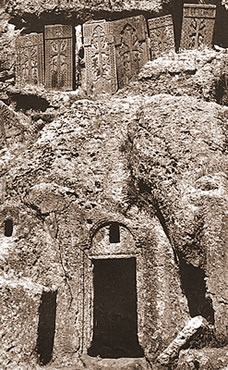Restoration of Kingdom
The Bagradouni Princes and the Arab expansion
Around 590, a new partition of Armenia between Persia and Byzantine Empire took place. Western provinces of the Greater Armenia were ruled by the kuropalats – governors of the Greek Emperor. The Mamikonean Princes gradually conceded their leading role to the other noble Armenian families. The Bagradouni Princes became especially powerful and influential.
Meanwhile, the Persian Empire fell into decay. In the early seventh century, a new power emerged in the Middle East. The Arabian Caliphate began first great expansions. Egypt and Syria became Islamic countries. The Persian troops were routed several times. By 680, Arabs destroyed the last remains of the Persian resistance and invaded all Persian territories. Zoroastrianism was replaced with Islam.
Arab invasions and Armenian revolts
The Arabs first invaded Armenia in 640. Prince Theodoros Rshtuni led the Armenian defense. In 652, a piece agreement was made, allowing Armenians freedom of religion. Prince Theidoros traveled to Damask, where he was recognized by the Arabs as the ruler of Armenia, Georgia and Albania.
By the end of the seventh century, the Caliphate’s policy toward Armenia and the Christian faith hardened. Special representatives of Caliph called ostigans were sent to govern Armenia. The ostigans made the city of Dvin their residence. Before Dvin was the residence of Armenian Catholicos.
 A gold dinar, of approximately AD 700, representing Caliph Abd-Al-Malik, from the British Museum.Although declared domain of Caliph, Armenia remained faithful to the Christian religion. The Arabs failed in several attempts to convert the Armenians to Islam. The Armenian obstinacy exasperated caliph Abd al-Malik. In 705, he gave to one of the ostigans an unprecedented order to murder all Armenian Nakharars. More than 400 Armenian noblemen were entrapped to one of Nakhichevan churches, then the doors were closed and the church was set in fire. Later, the Arab historians termed that time as The Year of Great Burning. Quoting John VI, “…ocean of tears flooded Armenia“. A number of unsuccessful insurrections followed that tragic event during the 8th century.
A gold dinar, of approximately AD 700, representing Caliph Abd-Al-Malik, from the British Museum.Although declared domain of Caliph, Armenia remained faithful to the Christian religion. The Arabs failed in several attempts to convert the Armenians to Islam. The Armenian obstinacy exasperated caliph Abd al-Malik. In 705, he gave to one of the ostigans an unprecedented order to murder all Armenian Nakharars. More than 400 Armenian noblemen were entrapped to one of Nakhichevan churches, then the doors were closed and the church was set in fire. Later, the Arab historians termed that time as The Year of Great Burning. Quoting John VI, “…ocean of tears flooded Armenia“. A number of unsuccessful insurrections followed that tragic event during the 8th century.
By 850, the Bagradouni Princes strengthened their position among the other noble Armenian families. The Prince Bagarat Bagradouni was the one who enjoyed the confidence of the high-ranking Arab officials. The Caliph granted him the title of Grand Prince. But soon thereafter, other Armenian Nakharars rebelled against him.
In 851 Yussouf, a Caliph’s commander, arrived to Armenia to put down the mutiny. To his surprise, he found nobody submissive. Enraged, Yussouf arrested the Grand Prince and sent him to the Caliph. A few later, the two sons of Bagarat revenged his father, raising the highlanders of Sassun province against Arabs. At nighttime, the armed multitude suddenly attacked the castle of Yussouf and killed him.
Furious, the Caliph sent a huge army, headed by Bugha. This commander, former slave, was known for his particular cruelty. Bugha’s campaign was truly devastating. Many Armenian cities and fortresses were destroyed and set ablaze. Historians termed Bugha as “butcher” and “brutal urderer”. The panic prevailed throughout the country. Only some few of the Armenian Nakharars put a stout resistance. Isaiah, the valiant Prince of Artsakh was Bugha’s most uncompromising opponent, but in the end Bugha seized him and sent to Baghdad together with other captive Nakharars.
Many of these noble prisoners met their death in the Baghdad dungeons. Being aware of the particular authority of Bagradouni Princes, the Caliph tried to convert them to Islam. Sembat Bagradouni, Sparabet of Armenia, refused to apostatize and was murdered after many cruel tortures.
Restoration of Kingdom
Ten years later Ashot Bagradouni, son of Sembat was proclaimed Prince of Princes. Wise and astute politician, Ashot resourcefully balanced between the Arabs and the Greeks. Under his ruling, Armenia enjoyed relative peace and prosperity. In 884, Ashot I was solemnly crowned King of Armenia. Both the Caliph and the Byzantine Emperor sent him a crown with many splendid presents, recognizing him as King. Thus, the Armenian Kingdom was de jure restored.
 Basil I, his son Constantine, and his second wife, empress Eudokia Ingerina.In the time of Ashot’s ruling, Basil I, the first Emperor of the Macedonian dynasty, came to throne in the Byzantine Empire. Basil I and a number of his successors were of Armenian descent. The new Emperor declared himself a descendent of the Armenian Arshakids kings. Traditionally, during the coronation ceremonies of the Armenian kings, it was a representative of Bagradouni family who solemnly laid the crown on the new king’s head. That’s why Basil I delegated a certain Nikita, his court eunuch, to Armenia asking Ashot Bagradouni to symbolically send him a crown.
Basil I, his son Constantine, and his second wife, empress Eudokia Ingerina.In the time of Ashot’s ruling, Basil I, the first Emperor of the Macedonian dynasty, came to throne in the Byzantine Empire. Basil I and a number of his successors were of Armenian descent. The new Emperor declared himself a descendent of the Armenian Arshakids kings. Traditionally, during the coronation ceremonies of the Armenian kings, it was a representative of Bagradouni family who solemnly laid the crown on the new king’s head. That’s why Basil I delegated a certain Nikita, his court eunuch, to Armenia asking Ashot Bagradouni to symbolically send him a crown.










